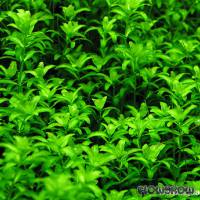



Baby tears, known as Hemianthus micranthemoides (or Micranthemum micranthemoides) in the hobby for decades, was discovered to be Hemianthus glomeratus by Cavan Allen in early 2011.
True Hemianthus micranthemoides is another species that has probably never been in aquarium cultivation. The last herbarium record of this plant from nature is from the year 1941, and the plant is considered missing and possibly extinct today. Hemianthus micranthemoides used to occur on the Atlantic coast of the USA between the states of Virginia and New York in fluvial tidal zones.
Hemianthus glomeratus, however, is endemic to Florida, where it can still be found in large numbers in its natural habitats. It grows, amongst others, in wet depressions and stagnant waters. Its emersed form, growing on wet soil, forms a dense, low, light green carpet of tiny creeping shoots.
The two Hemianthus species native to North-America can be discerned by means of their flower characteristics:
- H. glomeratus: Flowers are pollinated as soon as they are fully open (chasmogamous), calyx lobes are acute.
- H. micranthemoides: Flowers remain closed and pollinate themselves (cleistogamous), calyx lobes are obtuse.
The leaves of H. glomeratus sometimes are crosswise opposite (2 leaves per stem node), however, most frequently grow in whorls of 3 to 4 leaves per node. The leaves of submersed plants are lanceolate to elliptical, 3 to 9 mm long and 2 to 4 mm wide. Emersed plants remain far smaller than those cultivated submersed, have elliptical leaves and develop a creeping growth habit. Only the land form grows tiny whiteish flowers.
Another Hemianthus species hitherto not closer identified but resembling H. glomeratus is in cultivation under the name "Hemianthus micranthemoides". It differs from H. glomeratus e.g. by having only two leaves per stem node. For more details, please to go Hemianthus sp. “Amano Pearl Grass”.
H. glomeratus is a relatively undemanding plant that develops best under lots of light (approx. 0,5 watts per litre or more). Then it forms a dense bush with upright, slanted or even horizontal shoots. Under lower light, it grows vertically, forming long internodes. In well-lit aquaria it grows well even without the addition of CO2, however, when CO2 is injected into the tank its growth rate is higher and its habit bushier. If CO2 is deficient, greyish-white lime deposits may form on the leaves (biogenous decalcification). A regular supply of nitrate, phosphate, iron and micronutrients is of advantage, and higher phosphate levels of around 1 to 2 mg/l seem to induce the plant to form larger, more robust stems and to further growth. H. glomeratus is highly susceptible to fish medication containing Erythromycin or Tryptaflavin.
Like all stem plants, Hemianthus glomeratus is propagated by cuttings of stems that are taken out of the bush and re-planted in the substrate. The plant also spreads by growing roots on its creeping stems.
This Hemianthus can be used in many ways. Under intensive light it forms a nice carpet in the foreground, and when it is trimmed frequently it can be formed into a nice bush in the middleground. In small aquaria it can even form a decorative eyecatcher in the background of the tank. Its small leaves make Hemianthus glomeratus an especially interesting plant for nano tanks
<a href="https://www.flowgrow.de/db/aquaticplants/hemianthus-glomeratus" target="_blank"><img alt="Hemianthus glomeratus" title="Hemianthus glomeratus" src="https://www.flowgrow.de/db/widget/aquaticplants/hemianthus-glomeratus" /></a>
[url=https://www.flowgrow.de/db/aquaticplants/hemianthus-glomeratus][img]https://www.flowgrow.de/db/widget/aquaticplants/hemianthus-glomeratus[/img][/url]
[widget=aquaticplants/hemianthus-glomeratus]Hemianthus glomeratus[/widget]